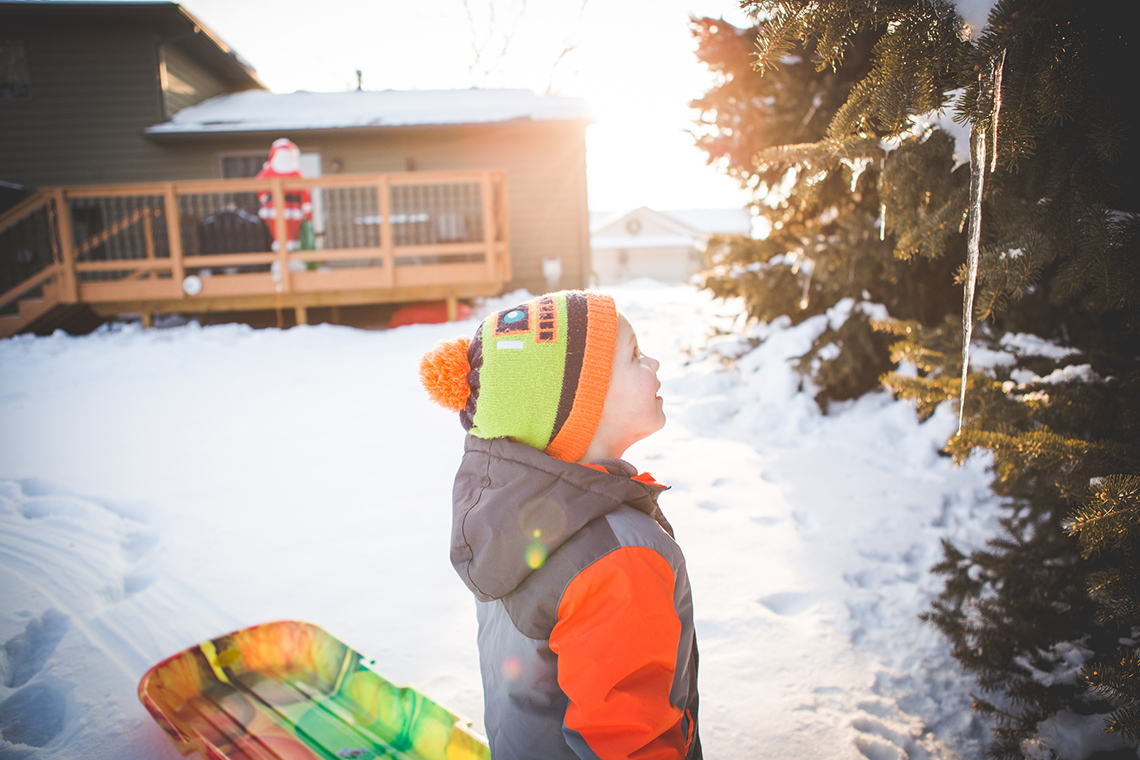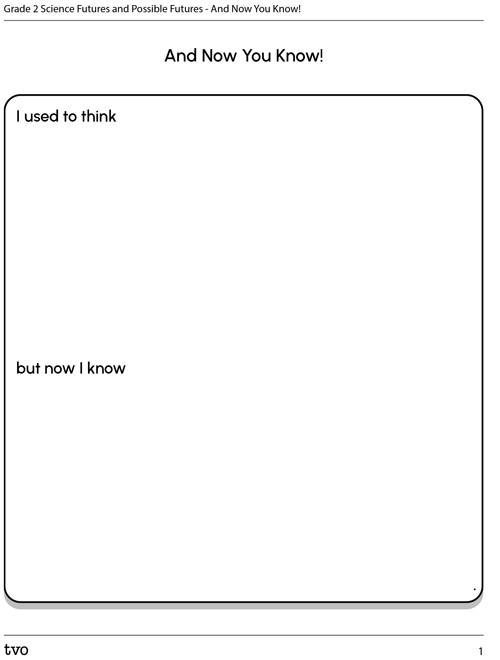Minds On
Investigating everyday

Grade 2 students use their questioning skills to learn more about how the world works each day.
Investigations happen indoors and outdoors, from early in the day until bedtime.
We use what we already know about the world, and our observations, to make predictions about what might happen next, or to ask questions to learn more.
As the seasons change, there is so much to investigate outdoors.
Investigation time!
Let’s investigate a video!
As we explore the following video, we will make and record our observations, answer what we think we know, and then we’ll predict what might happen next.
Observations

Time to learn! We can learn things from different places and people.

In this learning activity, we are going to learn through observations!
Observations are what can be noticed using the senses.
As you explored the video, you may have made some of the following observations:
- I notice liquid
- the liquid is clear
- the liquid is dripping
What other observations could a person notice?
What I think I know

We use what we already know to start to make sense of our observations.
Reflecting on the video, you may think…
What else do you think?
Predictions

Predicting is when you make a guess about what you think will happen in your experiment.
We create predictions by explaining what we think will happen next. A prediction makes use of what we already know, and what we have observed.
Check out the following way to start a prediction:
I think that (Blank) because (Blank).
You might have made the following predictions about the video you previously explored:
My predictions
Student Success
Student success
Using what you observe, what you think and what you predict, what could you tell someone about what you’ve been investigating?
Note to teachers: See your teacher guide for collaboration tools, ideas and suggestions.
Action
The science of snow

In the winter the temperature goes down and the air becomes colder. When temperatures drop and the air become cold, liquid in the environment freezes and turns to solid. The temperature will be zero degrees or colder for liquid to freeze to solid.
If the temperature stays below zero degrees and water has frozen, it will stay frozen until the temperature warms up and goes above zero degrees. When that happens, the frozen water will melt, and it will become liquid water again!
What are two ways liquid water can turn into a solid in the environment? Select two options from the following checklist.
Ways liquid water can turn into a solid:
When you’re ready, press the ‘Answer’ button to reveal the two ways liquid water can turn into a solid.
Liquid water can turn into snow or ice.


Pause and Reflect
How does water change?
How does solid water become liquid water?
When does liquid water stay as a liquid?
Record your answer on the computer, on paper, in a recording, or in a method of your choice.
Explore the following questions. Select the correct answer, then press ‘Check Answer’ to check how you did!
Designing and building snow structures
One example of an everyday investigation is the design and construction of a snow structure.
When building a snowperson, many tiny microscopic snowflakes are packed together to form a larger solid. The temperature needs to be below zero degrees. The snow needs to be just right to stick together.
Explore the following video about building a snowperson.
Take note of the steps that the learner uses to build a snowperson!
Now, place the design and building steps to making a snow person in the correct order.
Pause and Reflect
How can we build a snowperson?
In what state does water have to be in to build a snowperson? Why?
What would happen to the snowperson if the temperature was warmer than zero degrees for two days? Why?
Record your answers in a method of your choice.
Gliding on ice

Another example of an everyday investigation is understanding how to move across the ice.
You can move safely on slippery sidewalks, and for fun on an ice rink.
Explore ice with Howie, Baboo, and NHL skater PK Subban in the following video.

Time to learn! We can learn things from different places and people.

In this learning activity, we are going to learn through observations!
Observations are what can be noticed using the senses.
Use your observation skills that you used in the Minds On as you explore the following video.
Consider the following question:
What do Howie and Baboo learn from PK about how ice skates move across the ice?
Now, answer the following questions about the information from the video you previously explored.
We’ve learned some new information from Howie, Baboo, and PK! Consider the following checklist to think about your learning:
When I learn new information, I…
Student Success
Think!
Howie and Baboo end their investigations with the phrase “And Now you Know.”
Create your own sentence about ice and snow. Start your sentence with the following:
I used to think… but now I know…
You can record your sentence in the following fillable and printable And Now You Know! document. You can also record your ideas on paper, on the computer, as an audio recording, or using another method of your choice.
If possible, share your sentence with someone else to share what you know with them.
Note to teachers: See your teacher guide for collaboration tools, ideas and suggestions.
Symbols for danger
There are times when people need to be warned about dangerous situations. One of those situations is when water on roadways, sidewalks, paths or other surfaces have frozen and become icy.
Use your observation skills to explore the following images and descriptions of signs that warn people of ice.
As you explore the signs, consider the following questions:
- What is similar about these signs?
- What is different about these signs?
Record your ideas in a method of your choice.



Signs that warm people about situations and substances share messages in special ways.
Warning signs have a yellow background. This explains to people that there is a hazard nearby and to be careful. These signs also have black lettering or black images.
Traffic signs that warn people of a hazard are white triangles with red borders and black images and/or words.
In the following Matching activity, choose the warning message that best fits the sign!
Consolidation
Know your snow!
We have learned a lot about snow in this learning activity.
Answer the following questions about snow.
Make a prediction
Explore the following video of an ice rink.
Imagine someone was using skates to glide across or play hockey on the rink. Now, imagine the temperature warmed up.
What do you think would happen?
Let’s test your prediction!
Answer the following question.
Protecting others from ice
This learning activity connects new and existing approaches for young scientists to create positive changes in their communities.


A cold and rainy day!
Let’s use our imagination to consider the following scenario:
The temperatures are getting colder and the weather has been rainy. There are some places in your area where people travel. One dangerous area has a busy road and a sidewalk.
- Why might you worry about people travelling in this area if the temperature gets to zero degrees and it keeps raining?
- What signs could you use to warn people in this area about icy roads and icy surfaces?
- Why would these be the best signs for this purpose?
Record your answer in a method of your choice.
Reflection
How do you feel about what you have learned in this activity? Which of the next four sentences best matches how you are feeling about your learning? Press the button that is beside this sentence.
I feel…
Now, record your ideas about your feelings using a voice recorder, speech-to-text, or writing tool.
